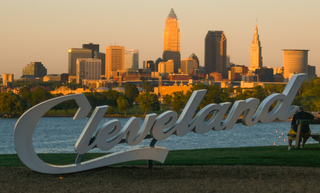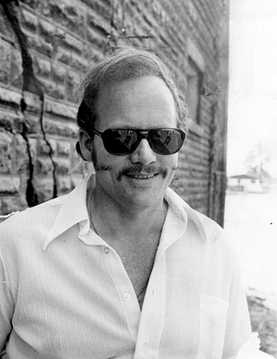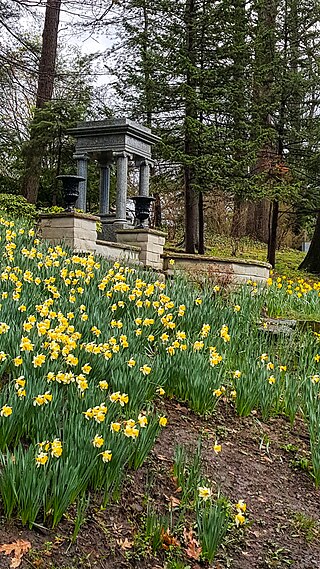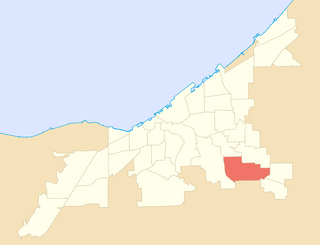
Cleveland, officially the City of Cleveland, is a city in the U.S. state of Ohio and the county seat of Cuyahoga County. Located in Northeast Ohio along the southern shore of Lake Erie, it is situated across the U.S. maritime border with Canada and lies approximately 60 miles (97 km) west of Pennsylvania. Cleveland ranks as the most populous city on Lake Erie, the second-most populous city in Ohio, and the 54th-most populous city in the U.S. with a 2020 population of 372,624. The city anchors the Cleveland metropolitan area, the 33rd-largest in the U.S. at 2.18 million residents, as well as the larger Cleveland–Akron–Canton combined statistical area, the most populous in Ohio and the 17th-largest in the country with a population of 3.63 million in 2020.

Cleveland Clinic is an American nonprofit academic medical center based in Cleveland, Ohio. Owned and operated by the Cleveland Clinic Foundation, an Ohio nonprofit corporation, Cleveland Clinic was founded in 1921 by a group of faculty and alumni from the Case Western Reserve University School of Medicine. The Clinic runs a 170-acre (69-hectare) main campus in Cleveland, as well as 14 affiliated hospitals, 20 family health centers in Northeast Ohio, 5 affiliated hospitals in Florida, and cancer center in Nevada. International operations include the Cleveland Clinic Abu Dhabi hospital in the United Arab Emirates and Cleveland Clinic Canada, which has two executive health and sports medicine clinics in Toronto. Another hospital campus in the United Kingdom, Cleveland Clinic London, opened to outpatients in 2021 and fully opened in 2022. Tomislav Mihaljevic is the president and CEO.

The Cleveland East Ohio Gas explosion occurred on the afternoon of Friday, October 20, 1944. The resulting gas leak, explosion and fires killed 131 people and destroyed a one-square-mile area on the east side of Cleveland, Ohio.

University Circle is a district in the neighborhood of University on the East Side of Cleveland, Ohio. It is home to the Cleveland Museum of Art, Severance Hall, the Cleveland Institute of Art, Case Western Reserve University, the Cleveland Institute of Music, the Museum of Contemporary Art Cleveland; the Cleveland Botanical Garden; historic Lake View Cemetery; the Cleveland Museum of Natural History; and University Hospitals/Case Medical Center.

Collinwood is a historical area in the northeast part of Cleveland, Ohio. Originally a village in Euclid Township, it was annexed by the city in 1910. Collinwood grew around the rail yards of the Lake Shore and Michigan Southern Railway and is divided by these same tracks into the neighborhoods of North Shore Collinwood and Collinwood–Nottingham. Collinwood was identified as one of America's Best Secret Neighborhoods by Travel + Leisure in 2008.

Samuel Andrews (1836–1904) was a chemist and inventor. Born in England, he immigrated to the United States before the American Civil War and settled in Cleveland, Ohio. He is best known as a partner in the oil refining firm of Rockefeller, Andrews & Flagler, the major predecessor company of the Standard Oil corporate empire. When the first unit was formed in 1870, Andrews owned 16.67% of Standard Oil stock. He sold his stock early on in 1874 and while he was wealthy, he did not participate in the level of wealth generation that the other founders did.

Daniel John Patrick Greene was an American mobster in Cleveland, Ohio, whose conflicts with the Cleveland crime family of the Italian-American Mafia ended in Greene's murder in 1977.
Gore Orphanage is the subject of a local legend in Northern Ohio, which refers to a supposedly haunted ruin near the city of Vermilion in Lorain County, Ohio. The ruin is a building that formerly housed the Swift Mansion and, later, the Light of Hope Orphanage, and is the subject of local urban legends, whereby the violent deaths of young adults and children are alleged to have occurred. According to the urban legends, supernatural activity has occurred in the building since its closure.
Collinwood High School is a public high school located in the Collinwood neighborhood on the east side of Cleveland, Ohio, United States. It is part of the Cleveland Metropolitan School District. The school is divided into three academies: Advanced Placement Academy, STEM Teaching Professions Academy, and Academy of Interior and Fashion Design.

Reverend Bruce W. Klunder was a Presbyterian minister and civil rights activist, born in Colorado, United States. He died when he was run over by a bulldozer while protesting the construction of a segregated school in Cleveland, Ohio. Klunder graduated in science from Oregon State University in 1958. While attending the school, he met his future wife, Joanne Lehman. The couple married December 22, 1956. He went on to earn his Bachelor of Divinity from Yale Divinity School in 1961. After college, Klunder and his wife moved to Cleveland where he was hired as assistant executive secretary of the Student Christian Union at Western Reserve University. He quickly became involved in the city's civil rights fight. He had a passionate interest in civil rights, headed the local chapter of the Congress of Racial Equality (CORE), and led a restaurant sit-in in Sewanee, Tennessee, in 1962. He and his wife had two young children at the time.

This is a list of the National Register of Historic Places listings in Cleveland, Ohio.

Calvary Cemetery is a Roman Catholic cemetery in Cleveland, Ohio, in the United States. The cemetery straddles the border between Cleveland and the city of Garfield Heights, with its offices within the city limits of Cleveland. Calvary Cemetery is the largest Catholic cemetery in Cleveland, and one of the largest in Ohio.

The James A. Garfield Memorial is a memorial for and the final resting place of assassinated President James A. Garfield, located in Lake View Cemetery in Cleveland, Ohio. The memorial, which began construction in October 1885 and was dedicated on May 30, 1890, exhibits a combination of Byzantine, Gothic, and Romanesque Revival architectural styles. Garfield, former First Lady Lucretia Garfield, and two other members of the Garfield family are entombed in the crypt level of the monument.

This article is a timeline of the history of the city of Cleveland, Ohio, USA.

Lake View Cemetery is a privately owned, nonprofit garden cemetery located in the cities of Cleveland, Cleveland Heights, and East Cleveland in the U.S. state of Ohio. Founded in 1869, the cemetery was favored by wealthy families during the Gilded Age, and today the cemetery is known for its numerous lavish funerary monuments and mausoleums. The extensive early monument building at Lake View helped give rise to the Little Italy neighborhood, but over-expansion nearly bankrupted the burial ground in 1888. Financial recovery only began in 1893, and took several years. Lake View grew and modernized significantly from 1896 to 1915 under the leadership of president Henry R. Hatch. The cemetery's cautious management allowed it to avoid retrenchment and financial problems during the Great Depression.

Hubbell & Benes was a prominent Cleveland, Ohio architectural firm formed by Benjamin Hubbell (1857–1935) and W. Dominick Benes (1867–1953) in 1897 after the pair departed from Coburn, Barnum, Benes & Hubbell. Their work included commercial and residential buildings as well as telephone exchange buildings, the West Side Market and Cleveland Museum of Art. Before teaming up, they worked for Coburn and Barnum. Benes was Jeptha Wade’s personal architect and designed numerous public buildings, commercial buildings, and residences for him including the Wade Memorial Chapel.

The Cleveland Trust Company Building is a 1907 building designed by George B. Post and located at the intersection of East 9th Street and Euclid Avenue in downtown Cleveland's Nine-Twelve District. The building is a mix of Beaux-Arts, Neoclassical, and Renaissance Revival architectural styles. It features a glass-enclosed rotunda, a tympanum sculpture, and interior murals.

Woodland Cemetery is a historic rural cemetery located at 6901 Woodland Avenue in Cleveland, Ohio. Established in 1853, it became Cleveland's main public cemetery after its founding and remained so for the next half-century. It fell into extreme disrepair, and most of its outstanding architectural features dismantled or demolished. In 1986, Woodland Cemetery was added to the National Register of Historic Places. The cemetery has since undergone restoration.

Union–Miles Park is a neighborhood on the Southeast side of Cleveland, Ohio, in the United States. The neighborhood draws its name from Union Avenue, and Miles Park in its far southwest corner.

Louise Klein Miller was an American landscape architect, educator, and curator of school gardens for the Cleveland public school system.




















